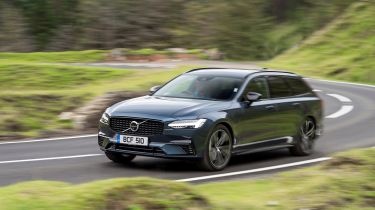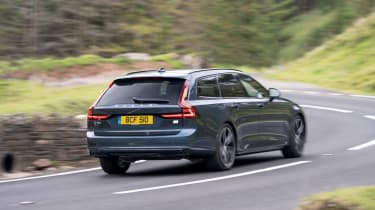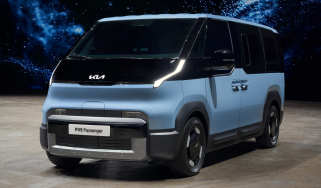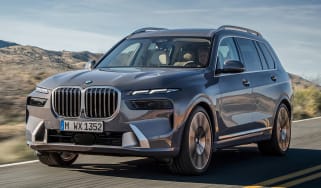Volvo V90 - Engines, performance and drive
The Volvo V90 has excellent cruising refinement but isn't the ultimate in this class for either ride or handling

Sensibly, the Volvo V90 has been developed to be a capable long-distance cruiser instead of something you’d want to throw around a Welsh B-road, and it has, for the most part, succeeded.
On a motorway, you should be pretty impressed by the V90’s ability to eat up long distances; both engines have enough punch to get you up to speed pretty quickly, and once you’re sitting at a fast cruise, they’ll fade away nicely into the background. Around town while utilising the electric motor, it’ll be even more refined than a traditionally powered petrol or diesel car.
The rest of the dynamic package is sensible and safe; the V90 stays stable and composed under braking, and while its steering is a little light, it is at least consistently weighted as you wind on lock.
If there’s a blot in the copybook, it’s ride quality. That’s not to say the V90 is particularly harsh or uncomfortable, it just isn’t quite as good at isolating you from sudden impacts with bumps as the Mercedes E-Class Estate. Choose the T8 Ultra which features adaptive dampers all-round and self-levelling air springs for the rear suspension, and it delivers a supple ride over bigger bumps, although sharp ridges and big potholes can catch it out and send a shudder through the cabin.
Used - available now
It’s still lovely to cover long distances in, because the dampers do a respectable job of maintaing composure, so it’s only big jolts and expansion joints at higher speed that affect comfort, lacking that final degree of finesse when compared with its rivals. There is a conventional suspension set-up on the T6 Plus, although we’re yet to try a V90 in this form.
Regardless of which engine you choose, you’ll end up with an eight-speed automatic transmission. There’s no manual gearbox, but you’re unlikely to miss it, because the auto has smooth and quick shifts. It does get caught out a little more frequently than the eight-speed automatic used by BMW, but not to the point where it’s an issue.
An arsenal of safety equipment – both active (which tries to stop the accident) and passive (which protects you when it’s happened) is available with the V90. Its features include large animal detection, which is designed to watch for creatures like elk and moose, but is also said to be capable of warning you when deer are at the side of a dark road in front of you.
The car also gets Volvo’s latest semi-autonomous technology, called Pilot Assist. You still need to keep your hands on the wheel to let the car know you’re ready to intervene, but do that and it’ll look after acceleration, braking and keeping the vehicle in the right lane. It works at speeds of up to 80mph, so it’s possible to use it on long journeys - though the real strength is in slow-moving or stop-start traffic on urban dual carriageways.
Engines, 0-60 acceleration and top speed
You couldn’t call the Volvo V90 slow, because even the entry-level T6 petrol plug-in serves up 345bhp and gets from 0-62mph in just 5.5 seconds, while the 449bhp T8 version cuts this down to 4.8 seconds. The top speed is limited to 112mph for all V90 variants.
Both plug-in hybrid versions accelerate faster than the BMW 5 Series Touring 530e or Mercedes E-Class Estate E 300 e, although the 5 Series and E-Class have higher top speeds.
More reviews
Car group tests
In-depth reviews
Used car tests
Which Is Best
Most Economical
- Name2.0 T6 [350] RC PHEV Plus Bright 5dr AWD Auto
- Gearbox typeSemi-auto
- RRP£62,865













